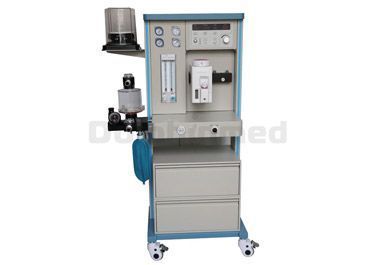Do you know the Anesthesia Machine air tightness check procedure?
The air tightness of the anesthesia machine is a prerequisite for the normal operation of the anesthesia machine, so it is very important to check the air tightness of the Anesthesia Machine.
As a Medical Anesthesia Machine Supplier, share with you the steps of air tightness inspection of anesthesia machine:
1) Close the APL pressure relief valve
2) Plug the Y-shaped opening of the pipeline by hand
3) Turn on the air source, and the output pressure is 0.2 ~ 0.5Mpa (excessive output pressure can easily collapse)
4) Turn off the flow meter and quickly oxygenate
5) Observe the airway pressure gauge
Anesthesia Machine
a. Maintain the pressure at 20-30cmH2O. If the pointer of the pressure gauge does not move or slips slightly within 2-3 minutes (the Y-shaped nozzle may not be tight and the pipe connection is not “welded to death”), it means that the anesthesia machine is not leaking.
b. If there is a leak, check the leak: After completing the above steps, turn on the flow meter and adjust slowly. Fresh gas enters the anesthesia machine and observe the pressure gauge. If the pressure gauge stops falling, the output of the flow meter is a leak. the amount.
If air leakage is less than 300 ml/min, normal surgery can be performed. Just increase the air leakage based on the normal flow adjustment.
If the air leakage volume is greater than 300 ml/min, the air leakage point should be checked first to solve the air leakage problem.
6) Inspection of air leakage point:
a. Leakage of carbon dioxide absorption tank: Improper installation, corrosion caused by organic solvents such as alcohol, etc.
b. Air bag leak: aged or damaged.
c. Leakage in pipes: aging or damage of black hoses, damage of threaded pipes.
d. Suction valve, exhalation valve: The surrounding screws are not tightened, and the inlet or outlet pipe is de-glued.
e. Leak in the volatile tank: leak in the connection port, replace the sealing ring; leak in the medicine pouring port (waste liquid discharge), reverse the pouring cap, and tighten; leak in the anesthesia tank, contact Yiren Hengye calibration service.
f. Air leakage of APL pressure relief valve: After removing the APL valve, block the connection port between the APL valve and the machine by hand, and vent to determine whether the APL valve is leaking.
What is the role of the anesthesia check valve?
The check valve of the anesthesia machine includes an inhalation check valve and an exhalation check valve. When the patient needs to inhale or inhale, the inhalation check valve is opened and the exhalation check valve is closed; when the exhalation is required, the exhalation check valve is closed. Open the suction single valve and close. What does this check valve design do? First of all, we introduce a concept: "dead space". Simply speaking, dead space is the part that is repeatedly inhaled. Specifically, the anesthesia machine is the part that is repeatedly inhaled before the Y-joint of the breathing circuit.
When repeatedly inhaling and exhaling, a part of the gas will be repeatedly inhaled, and a long time will cause the patient to die in the dead space.
When a one-way valve is added to the anesthesia machine ventilator circuit, the lower one-way valve is closed during inhalation, and the upper valve is closed when exhaled. Due to the flow characteristics of the gas, the repeated inhalation of gas is greatly reduced. Therefore, the one-way valve on the anesthesia machine is designed to reduce the amount of dead space.
Our company also has CO2 Absorber on sale, welcome to consult.






 English
English  French
French  Chinese
Chinese  Spanish
Spanish 















